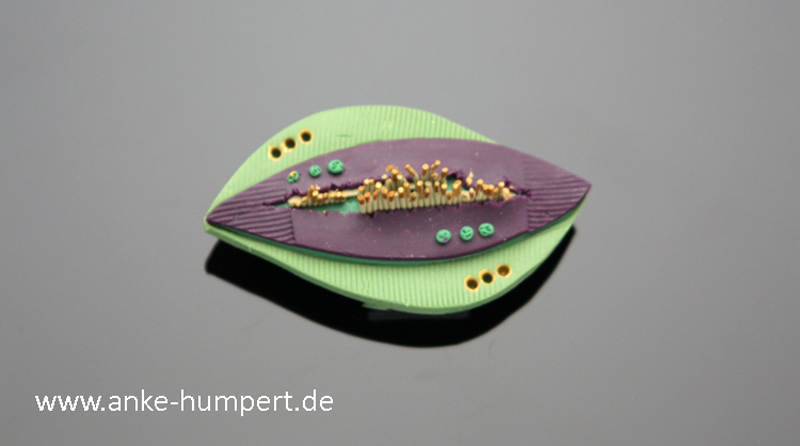One of the many qualities of polymer clay, that attracted me to this material, is its versatility and the ability to imitate other materials or objects. As a multimedia artist at heart I found polymer clay to be one of my go to materials exactly for that reason. These qualities are extremely intriguing, not only for me but for many that do work with polymer clay.
Mokume Gane originally is a metal technique used by artists to simulate wood grain in their pieces. This technique was taken over by polymer clay artists that did imitate the metal technique. So Mokume Gane in polymer clay is like a “double faux” technique that ironically proves how well polymer clay can almost be used for anything.
Of course Mokume Gane in polymer clay did not stay “just” imitate the metal Mokume Gane but it morphed and changed into all kinds of directions and is used in many different ways. Some of them are very far away from where it once started.
I personally have a kind of love/hate relationship with Mokume Gane in polymer clay: I love it because you can create stunningly beautiful intricate veneers and I hate it because I often feel I do lack control over the outcome of my pieces. There always is a lot of randomness in how my veneers will turn out: starting from the ways the colors react with each other, how the imprints in the clay will change the design and not to mention how the layers are cut to reveal the design of my veneers. While exactly that is one of the charms of this technique it does frustrate me at times and as an experiment I wanted to go exactly in the opposite direction! I am a bit of a rebel in that way and I am definitely curious enough to try to figure it out, if I can make it work! So I challenged myself to take back control over the outcome of my Mokume Gane veneers!
My crazy idea was to pair Mokume Gane with another love of mine: bold graphic art, as in graffiti, pop art or various print techniques. The half-toning that appears in all of these styles was exactly what I was looking for. So instead of using more and more different imprinting tools for my Mokume Gane veneers, I reduced the number of tools as much as I could until I was left with only one. And this tools is used in an extremely controlled way to transfer a halftone image to my Mokume Gane veneers.
I ended up with a lot of experimental pieces and of course some frustrating not so great pieces, so that I nearly gave up. But being stubborn in that way I tried to achieve what I wanted a couple of more times. And one time I felt as if I had hit the jack pot! I was rewarded with what I finally turned into my “Halftone Mokume Gane Eye” piece.

This veneer is proof of the possibility to transfer halftone images to Mokume Gane veneers. I created lots of beautiful veneers on the way and this technique still is somewhat uncontrollable. The beauty of chance has its own lure, of course, but when you are actually able to control your outcome it is priceless.
In my demonstration for the Polymer Arts Summit 2021 I will show the current state of my technique, it ́s possibilities and also it ́s limitations.












About the Presenter

Anke is a mixed media and polymer clay artist. Young at heart and mind, uber creative and “medium adventurous”, fearless about trying new things and making them her own.
She has an extraordinary eye for color and pattern. Her professional training at the University of Arts, Berlin, Germany, and her self-studies have encouraged her to find her own path in many ways. Anke enjoys most to explore creativity in all it s forms and help other people to find their own path to being creative.
Anke has published several books, ebooks and writes regularly articles for magazines. She is a demonstrator for polymer clay manufacturers, teaches classes on-line at CraftCast.com and in person workshops nationally and internationally.
Learn more about Anke’s session
Only 28 Spots Remain
Registration for the Polymer Art Summit closes on July 22. Don’t miss this online educational event, limited to 100 attendees – register today!
